With inflation still chipping away at family budgets and the price of energy still pushing everyone’s patience, the UK government’s £805 cost of living payment for 2025 couldn’t be more welcome.
For millions of low-income households, this isn’t just another line item in their bank statements — it’s a crucial buffer against mounting costs that appear to creep ever higher with each passing month.
So, who’s eligible? When will it arrive in your account? And how can people get the most out of this financial lifeline? Let’s break it down.
£805 Cost of Living Payment: What Is It?
The £805 sum is one of the targeted support measures being rolled out by the UK government to assist vulnerable families in financial distress.scroll to top sectionnowledgementsThe £805 sum is part of the targeted support initiative from the UK government to help struggling households continue to keep their head above water (financially) in difficult circumstances.
It would build on similar plans enacted in 2022, 2023 and 2024 — all of which were intended to soften the blow of exploding energy costs, rising rents and food inflation.
But instead of the past payments, which were frequently broken up into instalments, the 2025 bundle is to be given over in a “lump sum” – allowing those in receipt to budget for future spending and meet their most pressing needs right when they need it most.
Who Is Eligible for the Payment?
The £805 cost of living payment is only available to people on means-tested benefits. If you’re getting any of the following, you’re probably in the mix for the payout:
Universal Credit
Pension Credit
JSA (Income-based) 1 JSA (Contribution-based) and 2 JSA (Income-based) and JSA (Contribution based) together Income-based Jobseeker’s Allowance (JSA) If you are paid Joint or Couple JSA, see highlighted box for information on how it will be affected when the new rules come in.
Employment and Support Allow Cancer Income-related payable from day 1 Contribution-based from day 1 ESA.
Income Support
Working Tax Credit
Child Tax Credit
The payment will be automatic, so if you qualify, you do not need to apply or fill out any forms. So long as you were receiving one of the aforementioned benefits during the period when you qualified, the payment should be deposited straight into your bank account.
When Will the £805 Be Paid?
The Department for Work and Pensions (DWP) has said payments will start to be made in June 2025, and the majority of claimants will be paid by mid-July. If you don’t see your payment immediately, don’t panic: Payments will go out in batches over a few weeks.
Ensure the details of your bank account and information for contacts are current within your Universal Credit or HMRC account, so you are not delayed.
Why It Matters More Than Ever
Let’s face it: Although energy prices have moderated a bit from their 2023 peak, the price of essentials like groceries, transportation and rent stubbornly remains high.
What does £805 mean to someone who is a single parent on a benefits cap struggling to pay the bills, or a pensioner on a fixed income or a low wage worker living from one payday to the next?It’s not a bonus to those people, it’s a breathing space.
That payment helps cover the essentials: food in the fridge, heat in the home, or maybe just a little extra to make it to payday. It is not luxurious, in short — it is necessary.
Pros and Cons at a Glance
Pros Cons
✅ One-time lump sum provides immediate support ❌ It’s a short-term solution that doesn’t last
✅ Do not have to apply — you’ll get it automatically ❌ Doesn’t cover everyone who’s financially struggling
✅ Eases living costs and bills ❌ Won’t fully counteract inflation or rent rises
✅ Goes to millions of needy households ❌ Next installment won’t follow inflation tracking
£805 UK Cost of Living 2025
At a time when every penny counts, the £805 cost of living payment in 2025 is a lifeline.
That won’t fix all of our financial problems, of course, but it’s a step in the right direction — a small measure of relief for those who need some relief most.
Yet despite these reasons to celebrate, there is increasing demand for longer-lasting solutions to assist struggling families — be it through fairer wages, affordable housing or better access to public services. For now, payments like this one are a way of treading water.
If you’re eligible, watch your accounts in June — and take a moment to breathe a sigh of relief that help, however minimal, is on the way.
